

Nature's Tiniest Gems
Birds Unlimited Turns Backyards into Bird Havens


WHO WE ARE
IPUBLISHER | CATHY PAYNE
cathy@georgetownview.com
Like many of the best in her craft, Cathy has a specialized degree—in her case, hard science—and a gift for writing. She found her voice and fulfillment reporting and writing news and magazine features for a regional Central Texas audience. Along with serving as the publisher of the Georgetown View, Cathy oversees multiple magazines, marketing campaigns, and books.
SENIOR WRITERS / CONTENT EDITORS
Charlotte Kovalchuk • Ann Marie Kennon
CONTRIBUTING WRITERS
Linda A. Thornton
Steve Fought
CONTENT MANAGER
Camy Reynolds
GRAPHIC DESIGN
Sandra Evans • Ann Marie Kennon
Marilee Goldoni
CONTRIBUTING PHOTOGRAPHERS
Patrick St. Cin
BUSINESS DEVELOPMENT
Jesse Payne
WEBMASTER
Ann Marie Kennon
ADVERTISING
512.746.4545
info@georgetownview.com
Georgetown View is a Fidelis Publishing Group, LLC publication and a product of AdvocateNewsTX Newspaper.
Copyright © 2025 All rights reserved. Georgetown View is mailed monthly via USPS to homes and businesses in Georgetown, TX zip codes.
Mail may be sent to: Georgetown View P.O. Box 203 • Jarrell, TX 76537



n an age where the rush of daily news often overshadows the deeper narratives that shape our community, the Georgetown View constantly strives to be an eager beacon of positivity and unity. Far more than just a lifestyle magazine, our publishers and staff are committed to creating a means of getting to know what makes our community thrive: its people and their impact.
Since its inception, the Georgetown View has not only reported on the great stories and people in our city but also taken pride in actively contributing to its enrichment. Through donations exceeding $60,000 in advertising, we have extended our support beyond the printed page to organizations like the Mounted Warfare Museum, Brookwood in Georgetown (BiG), and the Williamson County Children’s Advocacy Center. These contributions further amplify the voices of those who work tirelessly to make a difference, ensuring their missions reach as many eyes and hearts as possible.
Moreover, we enjoy sharing our commitment to the animal companions of our community through regular features dedicated to the Williamson County Regional Animal Shelter, showcasing the importance of compassion. We are also pleased that our rotating nonprofit column further underscores this dedication by highlighting different support organizations each month, creating a platform for advocacy and connection.
But we are also good at doing what we do–showcasing prominent community agencies and initiatives like ROCK, Georgetown ISD students, FFA, 4-H, and many more on our covers and in multi-page features. These not only celebrate their contributions but also inspire readers to personally engage and participate in the missions of these community pillars. As well, timely articles featuring the Annunciation Maternity Home, Georgetown Arts District, and the Palace Theatre go beyond surface-level news, offering insights into the cultural and humanitarian assets of Georgetown.
In every story, from first responders and veterans to the latest city events and programs, our purpose is to foster a sense of pride and connection. In addition to these, each November, our "Giving Thanks and Giving Back" issue shines a spotlight on local nonprofits and philanthropic efforts, reminding us of the power of community support and the importance of gratitude.
In short, we believe the Georgetown View is more than a magazine; it is a vital part of the community’s fabric that spotlights advocacy, education, and celebration. We hope you will agree it stands as a testament to what we can all achieve when we choose to focus on the positive and the possible.
In today's dynamic market, visibility is key to success. We invite you to explore the power of diversification by previewing and investing in advertisement spaces across our diverse range of magazines. Each publication in our portfolio offers a unique audience, ensuring your message resonates with a wider, yet targeted demographic. Seize this opportunity to broaden your reach, enhance brand recognition, and connect with potential customers in new, impactful ways. Let's collaborate to make your brand a household name.
CONTACT US
512-746-4545 • INFO@GEORGETOWNVIEW.COM

ON THE COVER

Georgetown’s Wild Birds Unlimited is where birdwatchers—and their feathered friends—feel right at home, especially during hummingbird season. 8 12 14 16 19
COVER FEATURE
Wild Birds Unlimited is Turning Backyards into Bird Havens
WILLIAMSON COUNTY County & City Shelters Join Forces
EXPERIENCE
GEORGETOWN
Dachsund Group Meetups

AROUND TOWN Simple Sparrow Care Farm ASK A PRO Austin Orthopedic Institute PRP Therapy
22 26 30 35 36
KIDS & EDUCATION
GISD's Therapy Dog
Sponsored by Inner Space Cavern
ROCK-UMENTARY The Healing Power of Horses
THRIVING AFTER 55 Reading: A Common Thread
SHELTER STORIES A New Way Home
Sponsored by Countryside Pet Resort
PETS OF THE MONTH
38 41 44 46 48
WHAT MAKES TEXAS "TEXAS"? TEXAS SIT-REP Education Funding WORTH THE DRIVE Barkin' Springs
POPPY Same Calories, PARTING SHOT A Child's Mission


ASK A PRO • FEATURED PROFESSIONALS
Meet our Pros — professionals, business owners, and subject matter experts from leading local companies who share their knowledge and expertise to bring readers practical advice, how-to tips, best practices, and current and emerging trends. To learn more about becoming a Featured Professional, contact info@georgetownview.com or 512-746-4545.

Aqua-Tots Swim School Round Rock
The largest international provider of year-round, indoor swim instruction dedicated to teaching water safety through our proven curriculum.
Aqua-Tots.com/Round-Rock 512-336-8687

Austin Orthopedic Institute Board-certified orthopedic surgeon specializing in sports medicine, joint reconstruction, and orthopedic trauma, with over 15 years of surgical expertise.
AustinOI.com 512-856-1000

Doleva Elite Tree Certified Arborists to care for your trees! Our large equipment makes jobs efficient and economic, and prevents damage to lawn or property. Serving Georgetown since 2009.
DolevaEliteTree.com 512-943-8733

Hall's Roofing & Sheet Metal, LLC
Family owned since 1939. Roofing professionals specializing in full-service roof repair, installation, and replacement.
HallsRoofing.net 512-864-7579

Inner Space Cavern
One of the best preserved caves in Texas, Inner Space Cavern has hosted hundreds of thousands of visitors since 1966 and offers a variety of activities year round.
InnerSpaceCavern.com 4200 S IH-35 Georgetown


NextGen Academy
Empowering students with cutting-edge technology and innovative teaching methods to foster creativity, critical thinking, and future readiness.
NextGenAcademy.school 13915 US 183 Austin, TX 78717

DTC Air Conditioning
DTC provides advanced HVAC solutions with Carrier® factory-authorized service, expert technicians, and a commitment to innovation, training, and 100% customer satisfaction.
DTCTexas.com 512-887-5091

Keller Commercial & Home Services
Experts specializing in maintenance, enhancement, and design. Armed with cutting-edge tools and programs — driving rapid growth in architectural landscaping.
KellerServicesTX.com 512-930-4769

Prime Wellness and Longevity
Personalized hormone therapy, weight loss, and wellness plans to help clients optimize health, boost energy, and feel their absolute best.
PrimeWellnessand Longevity.com 512-240-4456

Laneways Enterprises, LLC
Family-owned expert welding services, specializing in high-quality construction, landscaping, and property management, plus metal structures and fencing.
LanewaysEnterprise.com 512-876-8921

& Amanda
Thousands of structures built since 2015.
MooreLibertyBuildings.com 512-548-6474

Sky & Co. Jewelry
Handcrafted elegance meets modern meaning. Sky & Co Jewelry creates minimalist pieces with lasting impact— designed to celebrate individuality, intention, and the stories you wear.
SkyCoJewelry.com 512-254-9337

The Wesleyan
Providing a new, bountiful experience of aging full of purpose, passion, and possibility for more than 50 years.
TheWesleyan.org
Moore Liberty Buildings Chad
Moore

•
•
•
•






Charlotte Kovalchuk and Ann Marie Kennon
Turning Backyards into Bird Havens
Wild Birds Unlimited: Georgetown’s Local Shop for Birdwatching Essentials
It starts with an ordinary backyard visit from a feathered friend. “One morning, you’ll spot a bird in your backyard and go, ‘Huh, I wonder what kind of bird that is,’ ” says Chris Darlington, owner of Wild Birds Unlimited. What begins as a moment of curiosity quickly turns into a joyful obsession—complete with bird identification apps, multiple backyard feeders, birdwatching adventures in local parks, and, eventually, a trip to Chris’s beloved shop where nature lovers come to swap sightings and stories. “I love my customers and their passion for birds and nature in general,” she says.
A NEW KIND OF CLASSROOM
As a child in Michigan and Ohio, Chris was inspired by her mother’s love of birds and still notes sightings in her mom’s dog-eared Audubon book. She carried her passion for nature to the classroom and before she became a store owner, she taught elementary science for 15 years. “I just love sharing knowledge and, working in the store, I am still teaching about nature, just to a different demographic.”
She found her way to the Wild Birds Unlimited franchise when her neighbor explained that yes, anyone can get a 20-pound bag of birdseed from a big box store but she happily drives 30 miles to the Lakeline Wild Birds Unlimited to get hers. Once Chris tried another brand and no birds came to her yard, she was inspired. She got online that night, realized it was a franchise with over 300 locations across the U.S. and Canada, and the rest is history. She purchased the Lakeline store in 2012 and opened the Georgetown location four years later.
Her Wolf Ranch store is crammed full of products: tray feeders, cylinder feeders, bird baths, books, and nearly 7,000 pounds of seed and mixes per week. Although part of a nationwide franchise, Wild Birds Unlimited feels more like a cozy boutique and is staffed with local experts who not only love birds but go through extensive training. Chris notes that staff do not work on com-

mission and she never wants customers to have buyer’s remorse. “For instance, we have the best feeders but we will not sell you a bluebird feeder if there aren’t any bluebirds in your area. Plus, we carry only the best seed you can buy, and many of our seed cylinders are made in New Braunfels, Texas.”
Every staff member can and is excited to answer questions about seed, feeders, nesting, squirrel and critter solutions, local species, eating periods, and the best use of anything in the store to help nurture new hobbies and interests. Even as the owner, Chris often helps customers in the store herself. “My favorite place is out on the floor. People come in here because they like to talk about their birds. They could get their bird supplies at other places but they love to come here and talk about their birds and which ones they’ve seen.”
In the spring and summer, the conversation revolves around one beloved bird in particular—hummingbirds.
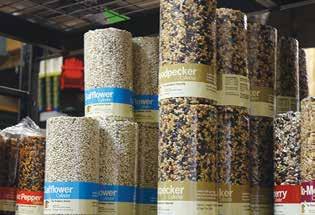
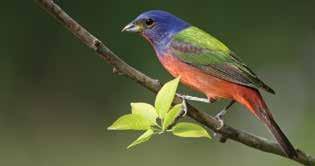
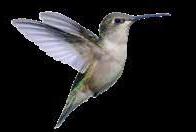
TINY BIRDS, BIG FASCINATION
With fall migration just around the corner, now is the time to keep your eyes peeled. For many bird lovers, spotting the first hummingbird of the season—often around St. Patrick’s Day—is like seeing an old friend. Their arrival marks the unofficial start of spring. But the real spectacle comes in autumn, when thousands of hummingbirds head south— many flying nonstop across the Gulf of America in an 18 to 22-hour journey that can span up to 600 miles.
These tiny creatures pack a big punch:
They’re the smallest birds on Earth and the only ones that can hover, thanks to their unique figure-eight wing beats.
Their wings flap 20–80 times per second, enabling speeds of up to 60 mph.
Their heart rates can exceed 1,200 beats per minute—and drop to 50 during rest.
They feed every 10 minutes and have incredible memories, often returning to the same yards year after year.

Their tongues capture nectar at lightning speed—up to 15 times per second. Hummingbirds are found only in North, Central, and South America and thrive in a variety of habitats—from deserts to mountains to backyard gardens. During migration season, if you spot 10 at your feeder, chances are 50 may have passed through that day.

WALKING ALMANACS
Ready to begin your birding journey? Chris and her staff are eager to help, starting with a few simple but essential tips.
Keep feeders clean—especially hummingbird feeders, which need fresh nectar every two to three days in the summer to prevent mold that can harm the birds.
Make sure your birdseed smells sweet, not stale or rancid, and place feeders in open areas where birds can easily spot them—not tucked into dense branches.
When new birders visit the store, Chris’s team starts by asking a few simple questions about their yard and the birds they hope to attract—then helps them find just the right setup to bring those feathered friends flying in.
WILD BIRDS UNLIMITED IS LOCATED IN THE WOLF RANCH SHOPPING CENTER
1013 W. UNIVERSITY AVENUE
SUITE 330 GEORGETOWN (next to ATI Physical Therapy) 512-763-1081 georgetowntx.wbu.com


IMAGE CREDIT CHRIS DARLINGTON


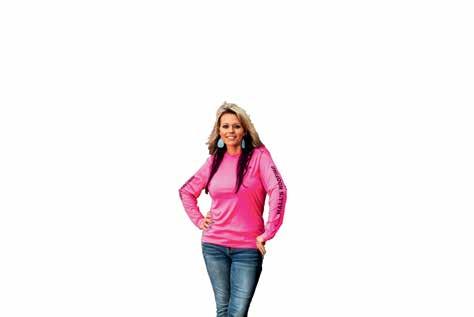



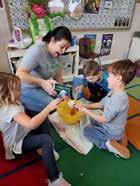


County, City Shelters Join Forces
Before Central Texas was hit with devastating flooding in early July, the Georgetown Animal Shelter was preparing for a gradual transfer of animals to the Williamson County Regional Animal Shelter (WCRAS). Instead, they found themselves packing up in a matter of hours. “All our plans went out the window. The flood pushed the transfer of animals over a few hours instead of a week,” says April Haughey, former animal services manager with the Georgetown facility, which is located near the San Gabriel River. When the river began flooding, the WCRAS team quickly stepped in—and within just three hours, 120 animals were safely evacuated to the county shelter.
While a crisis response wasn’t an ideal way to start the merger between the shelters, it underscored the strength of a partnership that had been years in the making.
PARTNERS IN PET CARE
On July 14, the merger between the Georgetown Animal Shelter and WCRAS officially took effect, creating a unified, countywide approach to animal sheltering. The idea had been in discussion for more than three years, spurred by Georgetown’s growing need for expanded services and the fact that WCRAS already operates within the city limits. “There was a lot of confusion for residents about which shelter they should go to,” says Ms. Haughey, the City’s assistant public works director. “In a way, we were also competing for resources, volunteers, donations, grants, and fosters since we were just a couple miles apart in the city. Now, we’re pooling those resourc es in one central location.”
The merger was unanimously ap proved by all participating regional partners, including Williamson County and the cities of Georgetown, Round Rock, Cedar Park, Leander, and Hutto.

NEW CHAPTER, SAME HEART FOR ANIMALS

All shelter services—including intakes, lost-and-found support, and cat adoptions—are now centralized at WCRAS at 1855 SE Inner Loop. As for the city’s former shelter, the facility has been re-imagined as the Red Poppy Adoptique—a home-focused facility built to serve the community with dog adoptions and fostering. “It will be a great way to spotlight them and help them find new homes as quickly as possible,” WCRAS Community Engagement Coordinator April Peiffer says.
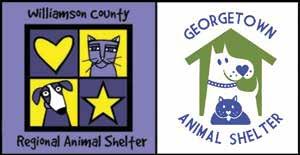
The Adoptique will also offer the popular Doggy Day Out program, along with the main campus, where residents can take a shelter dog on a short outing— whether it’s for a walk in the nearby San Gabriel Park or a cozy afternoon on the couch. The program runs daily from noon to 6pm, offering exercise for the dogs and a fun way for potential adopters to get to know them outside the shelter setting.
One of the biggest benefits of this new partnership is expanded access to services for Georgetown residents—many of which weren’t available before the merger. Now, locals can take advantage of:
Weekly Trap-Neuter-Vaccinate-Return (TNVR) clinics for community cats
Low-cost microchipping
Online licensing with Pet Hub ID tags
Supported re-homing opportunities
Broadened foster and volunteer opportunities
Community events such as vaccine clinics or lowcost spay/neuter services, with vaccines provided through support from Petco Love
WILLIAMSON COUNTY



Ms. Peiffer says, “The shelter has always had a regional approach and bringing Georgetown into the family will give residents access to services that we provide that they weren’t eligible for in the past. More access to services has a positive impact on the welfare of all the animals in our area.” The merger, she adds, “will also remove the confusion that often came when considering whether you should seek services with the County facility versus the City one, which will free up time for staff and make the services more efficient.”
HOW TO HELP
Support WCRAS’ lifesaving mission by getting involved—whether by fostering, adopting, volunteering, or simply spending time with animals through the Doggy Day Out program. Ms. Peiffer says, “We always welcome volunteers to our shelter and encourage the Georgetown community to continue their lifesaving efforts to help shelter pets by joining us here at WCRAS.”
To learn more, visit wilcopets.org

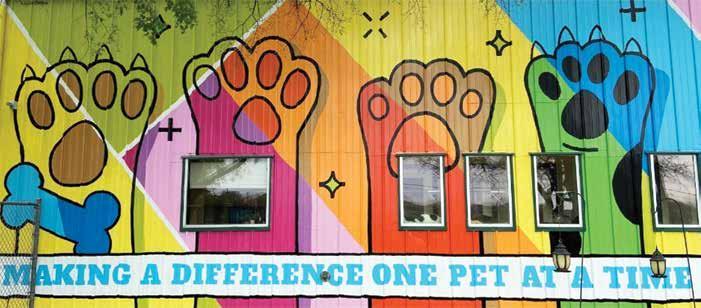
by Charlotte Kovalchuk •

EUNLEASHING PAW-SITIVE
COMMUNITY IN GEORGETOWN
DACHSHUND GROUP DESCENDS ON DOG PARK
very Saturday morning, the Georgetown Dog Park transforms into a playground for a pack of adorable dachshunds. Around 15 to 20 pups gather for off-leash play while their owners mingle—sometimes at the park and sometimes at other local dog-friendly spots.
Kacy Robertson


Kacy Robertson, founder of the GTX Weens Facebook group, still marvels at how a casual question she posted has grown into a thriving community centered on connection, compassion, and a shared love for dachshunds.
BELLA’S LEGACY
Kacy’s love for the breed began in her early twenties when she adopted her first doxie, Bella—a 7-year-old rescue who quickly became a comforting presence. Bella’s passing left a lasting impact, and dachshunds have been part of Kacy’s life ever since. Today, she shares her home with three: Hank, Cash, and Dolly. Dolly ultimately inspired GTX Weens. “She loves being around other weenies but doesn’t always feel comfortable around larger dogs. I realized there wasn’t a local space just for dachshunds to connect and play safely.”
After posting a question in a local Facebook group, the response was overwhelming. Less than a year later, GTX Weens has grown to nearly 500 members and become a vibrant hub for local dachshund lovers.
BUILDING COMMUNITY, ONE WAG AT A TIME
Seasonal events and themed gatherings add to the fun. From Halloween costume contests to charity raffles—like their recent fundraiser that brought in $400 for Central Texas Dachshund Rescue—GTX Weens is as much about giving back as it is about getting together.

What sets GTX Weens apart isn’t just the adorable dogs—it’s the community. “What’s really special is watching how the group has brought people together,” Kacy says. “It started with the weenies—but quickly became something more. I’ve seen genuine friendships form and even shy pups come out of their shells. For many of us, these meetups have become something to look forward to—a moment of laughter, support, and real connection.”
Looking ahead, Kacy hopes to grow GTX Weens with more fundraisers, rescue partnerships, and spaces for dachshund lovers to connect.
CALLING ALL DACHSHUND LOVERS
If you’ve got a dachshund—or just love them—you’re invited to join GTX Weens. “Our group is warm, supportive, and full of good vibes,” Kacy says. “There’s something magical about watching 20 dachshunds run around like it’s their own little paradise. It’s guaranteed to put a smile on your face.”
To learn more or join an upcoming meetup, scan the code above to check out GTX Weens on Facebook.
GTX WEENS MEETUPS ARE CASUAL, UPBEAT, AND FULL OF WAGGING TAILS. ON SATURDAYS AT 10AM , DACHSHUNDS AND THEIR HUMANS GATHER AT THE BARK PARK. THE GROUP ALSO HOSTS WEEN WALKS ON WEDNESDAYS AT SAN GABRIEL PARK AND OUTINGS TO LOCAL SPOTS LIKE BARKING ARMADILLO BREWING.
photos courtesy

AROUND TOWN
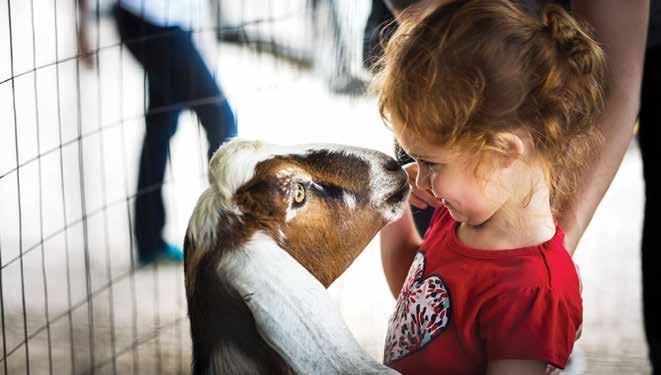
Where Healing Grows
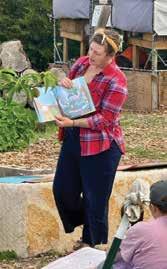
FEducation, Connections Take Root at SIMPLE SPARROW CARE FARM
or some, Simple Sparrow Care Farm brings back fond childhood memories like the familiar smell of their grandparents’ barn. For others, it’s a place to explore and learn through hands-on experiences with farm animals. And for many—veterans, foster families, and trauma survivors—it’s a safe haven to start their healing journeys.
In 2013, Jamie Tanner’s husband Eric surprised her with a two-acre plot of land in Hutto—a property that would eventually blossom into a community haven. Jamie, who grew up with an incarcerated parent and found refuge on her grandmother’s farm, wanted to pass that same sense of safety and peace to her children. But as she opened the farm’s gates to friends and neighbors, she realized the farm wasn’t just helping her family—it was nurturing many others around them too.
By 2017, Simple Sparrow Care Farm became a nonprofit, rooted in the belief that “potato farms grow potatoes, but care farms grow care.” Today, the farm partners with licensed therapists and educators to offer trauma-informed mental health care, spiritual guidance, and hands-on learning
programs. “It’s for anyone to find healing and the best version of themselves on the farm,” Jamie says.
CONNECTIONS ACROSS GENERATIONS
One of the ways Simple Sparrow Care Farm touches lives is by welcoming visitors of all ages through partnerships with several local nonprofits, schools, and churches. Among them are: A Gift of Time, which serves individuals with dementia, and Faith in Action, which offers rides and support to homebound seniors. “So many of them grew up on a farm and raised animals,” Jamie says. “Coming to the farm takes them back to their childhoods.”
And when seniors can’t visit the farm, the farm comes to them. Volunteers from Simple Sparrow travel to nursing homes with animals in tow, bringing comfort and joy to residents. Neurologists have observed that for many residents, especially those with advanced dementia, interactions with animals can also encourage speech and increased awareness.
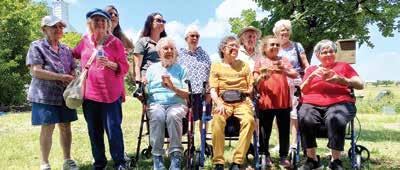
by Charlotte Kovalchuk • photos courtesy Simple Sparrow Care Farm

Beyond healing, Simple Sparrow’s programs plant seeds of empathy and compassion early in life. In its recent Little Care Farmers program, preschoolers cared for animals, read stories like The Very Hungry Caterpillar, and learned how different diets and food allergies create opportunities for understanding one other’s unique differences.
AROUND TOWN

One week, participants talked about food insecurity and packed lunch kits for people experiencing homelessness. Another week, they crafted shelters and learned about how animals—like people—need safe places to live. “It’s learning how we take care of one another, how animals take care of one another, and then asking, how can we show compassion and care to the community outside the farm?” Jamie says. “We’re providing opportunities for people to interact with nature in a very relational way, and that simple act is so powerful, it changes everything.”
Teacher and mom Rachel Lee couldn’t agree more. After adopting two kids from foster care, she found herself in need of peace and rejuvenation—both of which she found at Simple Sparrow Care Farm. “The farm became a place where I learned how to regulate myself in the hard moments. My kids also learned how to regulate themselves through the caring of animals.” No matter what needs or struggles kids have, “I feel like there’s a place here for each child.” Rachel’s sixthgrade classroom also participated in the PAW program, which allows local schools to foster rabbits during the school year. Thanks to Bear, the bunny they fostered, her students—who have behavioral issues and intellectual disabilities—learned how to slow down, practice gentleness, and recognize the needs of emotions of another living being. “I feel like he was our greatest regulation tool in the classroom,” Rachel says.
FALL FARM ADVENTURES
There are a variety of ways to experience the magic of Simple Sparrow Care Farm. This fall, the beloved Book & Bunny returns on Tuesdays at 9:30 to 10:30am from October 7 through November 11. Designed for preschoolers and their grown-ups, the free story time begins with a reading around the fire pit and ends with an invitation to explore the farm.
For curious first-timers, the farm opens its gates to the public on the first Saturday each month from 9 to 11am. These free, open farm days are relaxed and welcoming, offering families and individuals the chance to explore the property, pet animals, ask questions, and learn more about what care farming is all about.
And for those with preschool-aged kids eager to get their hands dirty and explore the world around them, keep an eye out for the next session of Little Care Farmers that Jamie and her team hope to bring back this fall.

To learn more, visit simplesparrow. farm and follow Simple Sparrow Care Farm on Instagram.

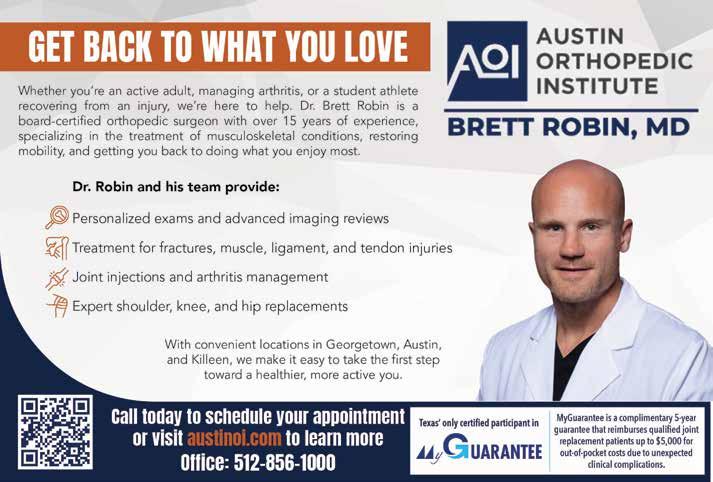

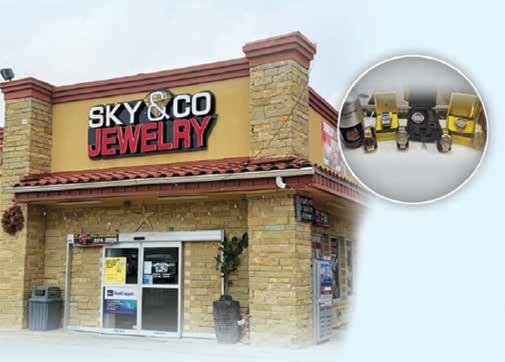




PRP THERAPY Your Body’s Natural Healing Power
Austin Orthopedic Institute
Board-certified orthopedic surgeon specializing in sports medicine, joint reconstruction, and orthopedic trauma, with over 15 years of surgical expertise. AustinOI.com • 512-856-1000
"THE PRP TREATMENT WAS LIFE-CHANGING. ABOUT 3-4 WEEKS AFTER TREATMENT, I BEGAN NOTICING IMPROVEMENT, AND BY 4-5 WEEKS, I WAS COMPLETELY PAIN-FREE. I WENT FROM HAVING MY KNEE LOCK UP TO RETURNING TO ALL MY NORMAL ACTIVITIES. I DIDN’T KNOW HOW MUCH PAIN I WAS IN UNTIL IT WAS GONE.” ~ GEORGIA S.
If you’ve heard about professional athletes using platelet-rich plasma (PRP) therapy to speed up recovery, you might wonder if this treatment could help you too. As an orthopedic surgeon, I’ve seen how PRP helps both young athletes and active adults heal faster from injuries.
What is PRP Therapy?
Many people refer to PRP as stem cells. This is technically incorrect, but the concept is similar. PRP therapy uses your own blood to help heal injuries. Here’s how it works:
We take a small blood sample, spin it in a centrifuge to concentrate the platelets, then inject those platelets into the injured area.
Think of platelets as your body’s natural repair team. PRP gives you at least five times more healing platelets than normal, supercharging your body’s repair process. These platelets release growth factors that tell your body to build new, healthy tissue.
How PRP Helps Young Athletes
For student athletes, PRP can be a game-changer. Young bodies heal well naturally, and PRP makes them even better. My own son had a recurring hamstring tear that threatened his senior football season. After PRP
injection, he returned to the starting lineup five weeks later and finished the season strong, even playing in the state championship.
PRP works especially well for common sports injuries like muscle strains, tennis elbow, knee pain, Achilles problems, and partially torn ligaments.
Benefits for Active Adults
As we age, healing slows down— but PRP helps bridge the gap. I’ve had great success treating arthritis pain, chronic shoulder issues, persistent elbow pain, and hip or knee problems that limit activity.
What to Expect
The PRP procedure is simple and done in-office:
BLOOD DRAW: 60–90 cc from your arm
PROCESSING: 15 minutes in a centrifuge
INJECTION: Concentrated platelets into injury site
RECOVERY: Home same day
The whole process takes 30–45 minutes. Most say the injection feels like a regular shot.
Recovery and Results
You may feel soreness at the injection site for up to three days—this
is normal and signals healing. Most return to regular activity within days, though strenuous exercise should wait 3–4 weeks.
Many notice improvement within two to four weeks, with continued progress over 3–6 months as new tissue forms.
Important Considerations
PRP is considered experimental by insurance, so patients pay out-ofpocket (HSA accounts can be used). Studies show over 80 percent patient satisfaction, with pain relief lasting 12–24 months or more.
Because it uses your own blood, there’s virtually no allergy risk. Serious complications are rare and less likely than with steroid injections.
Is PRP Right for You?
PRP may help if you’ve tried other treatments without success, want to avoid surgery, have chronic pain, or are recovering slowly from injury.
The goal isn’t just to treat symptoms—it’s to help your body heal so you can return to an active, pain-free life. In a consultation, we’ll evaluate your condition and determine if PRP is right for you.










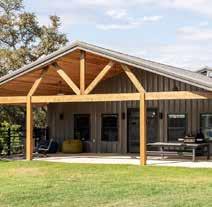
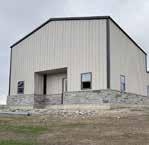












by
PAWS FOR HEALING Brings Comfort, Connections

DOG’S-EYE VIEW OF HEALING
But when Tara joined -
tional love could make a difference.
At the Williamson County Juvenile Justice Center, many students arrive carrying the weight of significant trauma. Emotional dysregulation is common—some pace, raise their voice, cry, or retreat into silence. Tara Stewart, principal of the S.T.E.P program, recalls one girl who, at her previous school, could remain dysregulated for up to two hours. After transferring to the center, staff were able to help her calm down in 45 minutes. The next time, when the school’s therapy dog Luna Raptor was present, it took just five.
Luna, a 6-year-old golden retriever, has been a certified therapy dog through Alliance of Therapy Dogs since she was 2. Tara originally began training another one of her dogs with a different mission in mind—helping wounded soldiers
therapy dog to the campus,
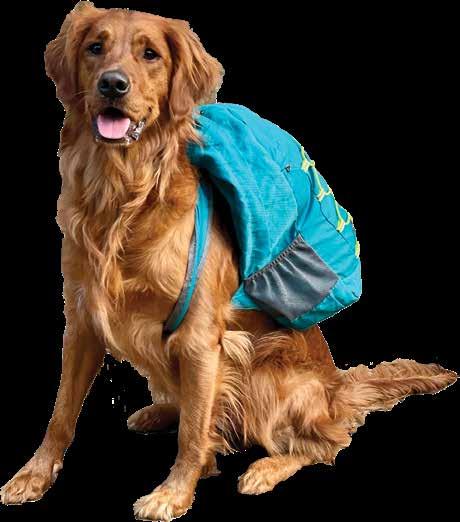
their team. Her name, inspired by the gentle and good-hearted Luna Lovegood in the world of Harry Potter, reflects the role she plays at the center—offering comforting, non-judgmental support to students and staff alike.
Now in her fourth year at the center, Luna supports students across all three educational programs housed within the facility: the shortterm detention program, the long-term residential treatment program, and the Juvenile Justice Alternative Education Program for kids who have been expelled from their home campuses. Students are elementary through high school age, with some pursuing a GED.
When Luna walks into a classroom, she doesn’t need to be told where to go—she instinctively gravitates toward the student who needs her most. Whether it’s locking peaceful eyes with someone having a hard time, or lying across a nervous kid’s feet when they first arrive at the juvenile justice center, Luna knows exactly what each student needs at that moment. “I like that Luna knows when people are down and tries to help,” one student wrote in a school letter. Another note read, “She makes a smile appear on my face and maybe she understands better than a human.”
Another girl, who came to the center terrified of dogs, now lights up whenever she sees Luna and shouts her name across the hallway. One student, disappointed whenever his dad failed to show up for a scheduled furlough visit, would sink to the floor and bury his face in Luna’s fur.

Charlotte Kovalchuk • photos courtesy Tara Stewart

Those kinds of encounters are backed by science— research shows therapy dogs can increase serotonin, reduce cortisol, and lower the heart rate and blood pressure. In a high-stress environment like the juvenile justice center, those effects are transformational. Tara says, “I love watching other people’s faces and seeing how happy she makes them.” So much so that she doesn’t mind being called the Dog Lady whenever she and Luna are out and about. “And they say Luna’s name first. I’m secondary,” she laughs. As one of her school shirts says, “I’m the one who’s just here to hold the leash.”
PAWPRINTS ON THE HEART
Beyond the juvenile justice center, Luna brings the same healing presence to events throughout the school
district. She attends the State of the District and other GISD events, joins Zoom meetings, appears in public service announcements (like safety reminders about wearing eclipse glasses), and dresses up for school spirit days. On Valentine’s Day, she stars in the school’s Kissing Booth, where students get to line up for pictures with her. She even serves as a recruiting tool, with applicants sometimes responding to job postings simply because they saw that the center has a therapy dog.
But even with her growing public presence, Luna’s greatest impact is felt in the day-to-day connections she builds on campus—with students and adults alike. “She definitely is on call for the kids. But the adults use her just as much,” Tara says. “She’s everybody’s favorite employee.” Juvenile Services Executive Director Scott Matthew says, “She’s got the best job in the world. She makes everybody smile.” Tara agrees, saying, “It’s very obvious that she finds joy in her work. She’s so excited to come to work every day. In the summer, when her teachers aren’t here and she doesn’t get to see all the kids as often, she almost gets depressed. We have to go and find kids to help her.”
Scan the code to follow Luna' campus adventures on Instagram.




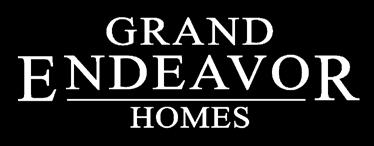
Scenic 1+ Acre Lots in Georgetown
Private Gated Community
Secluded Hill Country Views
Model Home Open Daily

Build On Your Lot or Ours




ROCK Documentary HighlightstheHealingPowerofHorses
Before stepping into the dirt arena at Ride On Center for Kids (ROCK), local filmmaker Twila LaBar had no idea about the nonprofit’s life-changing, equine-assisted therapy that was quietly transforming lives. At the time, she was busy filming a documentary about Georgetown’s first hospital with George and Barbara Brightwell, longtime residents who had donated the original 20acre Georgetown property for ROCK, which has since expanded to 60 acres. The couple couldn’t stop talking about the organization where individuals with disabilities and PTSD find healing through horses. They urged her to visit the center and witness its impact for herself. After touring the facility in 2018 and talking with founder Dr. Nancy Krenek, Twila fell in love with the “beautiful place” where she felt an overwhelming sense of peace.
FROM SADDLE TO SCREEN
At first, Nancy was hesitant about the idea of a documentary about ROCK. “We don’t make documentary films; we’re in the dirt with horses and participants, helping people,” she told Twila. But the Brightwells, the film’s executive producers and primary donors, were passionate about shining the spotlight on the nonprofit and its transformative work. The couple, who have since passed, had the chance to watch a final cut of the film before it was released.
As she spent more time with ROCK’s participants, Twila began to understand that the healing didn’t stop when the sessions ended. “We wanted to show what happens at ROCK, but also how it impacts participants’ lives outside ROCK. I’m so blown away and moved by how the lives of participants are transformed because of the horse and the people who believe in them and empower them to pursue their dreams.”

What began as a casual visit soon evolved into a passion project—a documentary called Where the Horses Heal the Soul. Over the next few years, Twila and her crew followed the journeys of several ROCK participants and captured the ways their time in the saddle opened doors to healing, connection, and renewed purpose.
There’s Hunter Adkins, a woman with cerebral palsy whose time on horseback brought strength and purpose. Faith Smythe, a young woman with Down syndrome who discovered joy and strength through her rides. Todd Plybon, a veteran and former high school teacher who found healing and hope through his bond with a horse after sustaining traumatic brain and leg injuries during combat. And Will Estrada, a veteran with severe PTSD who experienced peace and purpose from his interaction with the horses.



TAKING ROCK’S STORY AROUND THE WORLD
Since its release, Where the Horses Heal the Soul has resonated with audiences around the world. Screenings have taken place at film festivals and equine therapy centers across the United States and internationally—from Texas, New York, and Vermont, to one in South Africa in September. The film has won multiple awards, including Best International Documentary Film at the Equinale Film Festival in Germany and Best Documentary Feature at the Crown Pointe International Film Festival in Chicago. The documentary will also be featured at the GTX Film Festival on September 27.
Some equine-assisted therapy centers have used the film to raise awareness and funding, while viewers—some of whom had never interacted with horses before—have reached out about how the film inspired them. “Horses really can help people and transform lives,” they will tell Twila—words she knows the Brightwells would have loved to hear. “That’s what George and Barbara wanted—for the ripple effect of ROCK to go around the world with this film.”
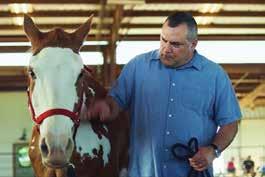
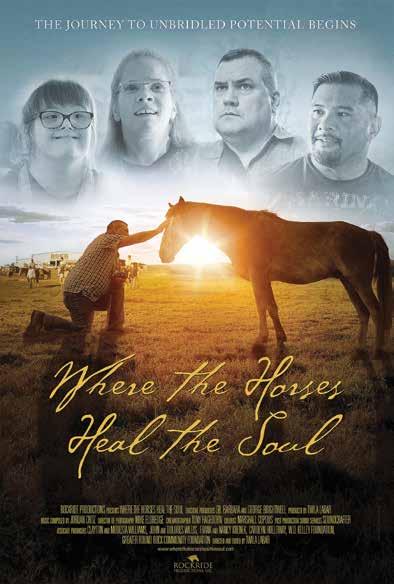
Twila and her team are working to make the film available on streaming platforms this fall so even more people can witness ROCK’s transformative power of healing through horses.
To stay up to date on the documentary’s release and future screenings, visit wherethehorseshealthesoul.com.
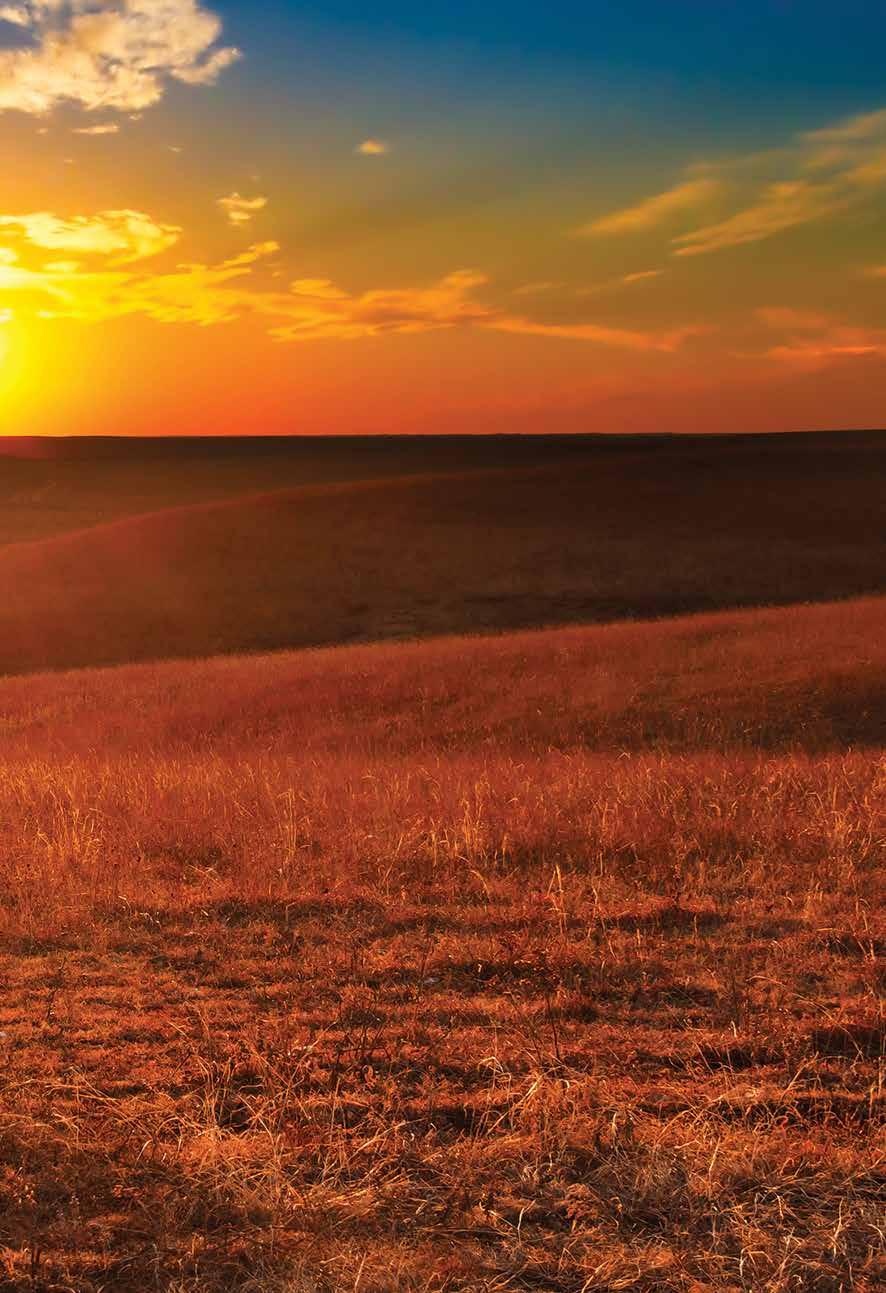

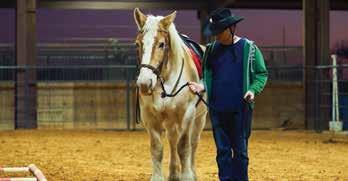



A Common Thread
USING THE DOG DAYS OF SUMMER TO GROW, LEARN, AND THRIVE
August brings the “Dog Days” of summer. In ancient Greece and Rome, those were the days when dogs and men alike would be driven mad by the extreme heat. Even though times have changed (and we have air-conditioning!) it’s still a good time to stay inside, contemplate, and prepare for the months ahead so we can, indeed, “thrive after 55”.
SO, WHAT DOES IT MEAN TO “THRIVE”? ACCORDING TO THE DICTIONARY, TO THRIVE MEANS: (1) TO GROW OR DEVELOP WELL; AND (2) TO PROSPER, BE SUCCESSFUL, AND FLOURISH. THE FIRST PART IS PREPARATION; THE SECOND PART IS ABOUT REAPING THE RESULTS.
Many people think of success as a result of luck, circumstance, or good fortune. While luck may play a role in success, the people considered most successful share some common habits of preparation, and maintain their level of knowledge, enthusiasm, and enjoyment.
SUCCESSFUL PEOPLE READ. A LOT.
By reading, these top-tier individuals learn from people who have come before and from contemporary masters. Theodore Roosevelt, and Queen Elizabeth I were famous readers. Abraham Lincoln was a self-learner and once said, “All I have learned, I learned from books.” Warren Buffet is said to spend eight hours a day reading in one form or another. Former President Barack Obama, Richard Branson, Bill Gates, Oprah, Mark Zucker berg, Reese Witherspoon, J.K. Rowling and many successful people even share what they read in public.
LOCKED OUT WITHOUT LITERACY
At the other end of the spectrum, people who can’t read are locked out of much of the world’s knowledge. It’s nearly impossible to learn if you can’t read the material on the page. If you can’t read it’s very difficult to even navigate your way through everyday tasks, understand warnings, alerts, cautions or directions, or even to communicate to others. If you can’t read, hardly anything else matters.
A National Adult Literacy Survey revealed that 70 percent of incarcerated adults cannot read at a fourth-grade level. Other similar studies indicate 85 percent of juvenile offenders are functionally illiterate and, consequently, can’t manage their finances, understand instructions, or fill out basic forms. This, in turn, leads to them only being able to obtain jobs with lower pay, higher rates of unemployment, and limited opportunities for professional or economic growth.
Reading, per se, is neither a necessary nor a sufficient condition for success or failure. Despite there being no proven causal relationship between reading and success or failure, there is a strong correlation between reading and life’s outcome. The evidence strongly suggests successful people make time to read. And, since you’re reading this, you’ve already decided that reading is important. That puts you well ahead of the power curve.


BUILD A READING HABIT
I’m going to be presumptuous now and offer a framework for selecting reading materials, organized around current events, professional and personal development, and entertainment.
For news, current events, and professional development—and on a regular basis—read a local, regional, national and international newspaper (or e-media), and/or the professional journal in your field. I suggest you pick these sources from across the political spectrum, not just the ones that align with your personal beliefs. I’ve found liberal and conservative sources can report on the same event, but their narratives suggest the reporters were on different planets. I’m fond of the Wall Street Journal for national news and The Economist for an international perspective.
REVISIT THE CLASSICS WITH NEW EYES
For personal development, consider a classic, one no-brainer shoot-’em up, and one on a contemporary topic that piques your curiosity. I’ll not attempt to offer a list of no-brainer novels since the world is littered (literally) with possible choices.
But for a classic text you might consider something you read when you were younger; you’ll be amazed at how your perspective has changed now that you’re a bit more mature. I re-read Harper Lee’s To Kill a Mockingbird, George Orwell’s Nineteen Eighty-Four, and John Steinbeck’s The Grapes of Wrath this past year. Gina is reading a series of historical treatises written by David McCullough (e.g., John Adams, Mornings on Horseback, The Johnstown Flood, The Great Bridge, The Path Between the Seas, etc.).
You might also peruse some of the bestseller lists. I’m waiting for Tim Minshall’s How Things are Made to be available in the Georgetown library. It was recommended by the WSJ and deals with international manufacturing, trade, tariffs, and all sorts of other hot-button issues in today’s political environment.
Gina just finished Kristian Hannah’s The Women (about nurses in Vietnam), Nathalia Holt’s Wise Gals (about the CIA), Robert Edsel’s Monuments Men (saving the world’s art in and after WWII), Queen Noor’s account, Leap of Faith: Memoirs of an Unexpected Life (a fascinating inside-look at Middle East culture, politics, and personalities) and is currently absorbing Michael J. Fox’s Lucky Man (an autobiography dealing with Parkinson’s).
Outside this framework, I also have two books I read every four or five years. The first is Richard Bach’s Jonathan Livingston Seagull. That book reminds me of the need to be confident in being different, to separate from the flock, and excel on our own terms. The second is Walter Van Tilburg Clark’s The Ox-Bow Incident. That book is a seminal reminder that one should never, ever, convict anyone on the basis of what you read in the media or hear on the street. Never. Ever.
YOUR TICKET TO SUCCESS
To achieve and maintain success, you need to be systematic in your search for new knowledge and perspectives. That needs to be a way of life. Reading is intellectual travel. Through reading, you journey to parts of the world, at past, future or even present times, and encounter people and circumstances from which and from whom you can learn. These experiences, gained freely and without risk, spark enthusiasm, creativity, and success.

Fortunately, Georgetown has a wonderful library that’s chock full of books, updated regularly, and an expansive e-book collection that can be downloaded. There’s also an array of special programs and events spanning the spectrum of interests, ages, and topics. Finally, they have Words on Wheels (appropriately named WOW!), that delivers books to sites scattered throughout our community. I encourage you to take full advantage of all this and set a pattern of reading during these Dog Days of Summer.
I wish you well on your reading journey.
Go For It!


Tired of Just Treating Symptoms?
Blending the strengths of multiple healing disciplines, integrative medicine offers a comprehensive path to long-term health and resilience.

• Conventional and Alternative Therapies
• Personalized Treatment Plans
• Sustainable Solutions for Optimal Wellness
• Cutting-Edge Leading Technology
Membership Discounts



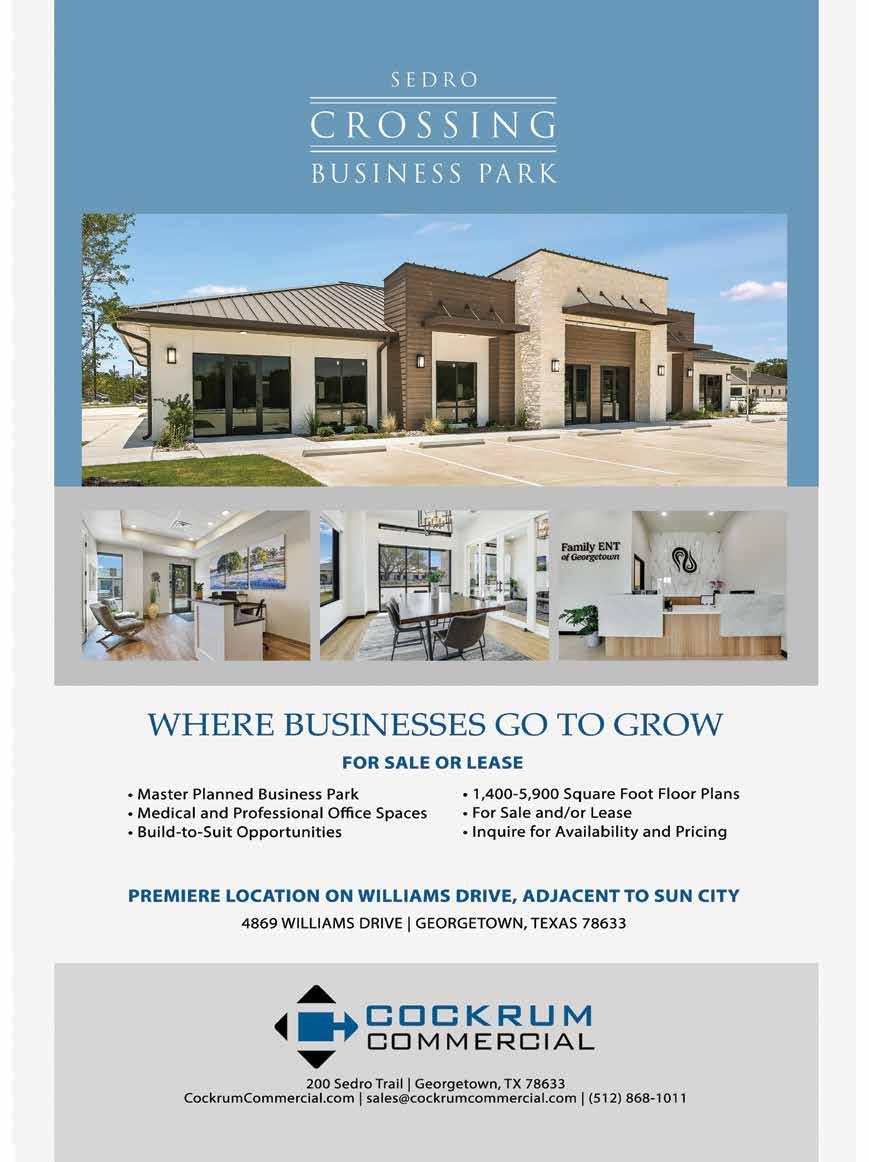

Let Your Pet Be Our Guest!










A New Way Home
Williamson County’s Microchip Stations Make Pet Reunions Easier
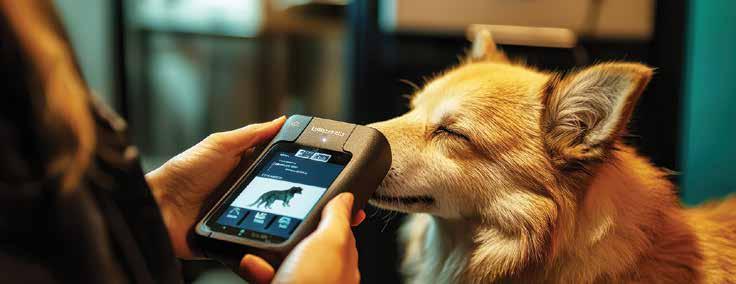
For pet owners, the idea of their furry friend going missing is a nightmare. But what if the path home didn’t have to start at a shelter? What if reuniting lost pets with their families could happen right where they were found—before the animals ever enter the system?
That’s the vision behind the Williamson County Regional Animal Shelter’s (WCRAS) new Reunion Stations—a network of 24/7 microchip scanning kiosks set to pop up across the community.
These stations would allow anyone who finds a lost pet to scan for a microchip and contact the owner directly, skipping the shelter entirely.
The idea was sparked during a conversation among animal welfare professionals, including WCRAS Director of Animal Services Misty Valenta, about the confusing and often inconsistent messages given to the public on what to do when they find a stray. Wanting to provide a solution in her own community, she began looking into ways to help reunite pets and their families quickly. Around that time, she discovered a reunion station—once an old news-
paper stand transformed by a local Girl Scout troop into a microchip scanning kiosk. Inspired by its simplicity and ingenuity, Misty set out to bring the neighborhood pet reunion concept home to Williamson County.
Since then, the shelter’s team has been working on making microchip scanning a reality countywide. WCRAS’ Community Engagement Coordinator April Peiffer says, “We want to see the community take advantage of all of the tools available to them so when they find a lost pet, they can facilitate a reunion as quickly as possible, which may often mean never coming to the shelter at all. As word spreads, we hope other communities will choose to follow suit and make this the standard everywhere.”
The first official Reunion Station was installed outside the shelter’s Services Center in Georgetown, with plans to launch eight more in Round Rock. WCRAS hopes to eventually place a station in every zip code in Williamson County using GIS mapping to ensure strategic placement and accessibility.
While the project is still in its early stages—so far, no reunions have been logged through the new stations—the shelter’s team is optimistic about its ability to help lost pets get home faster. “We know most
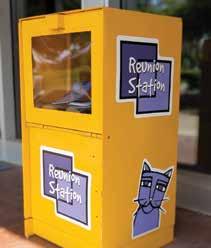
pets are found within two miles of their homes,” Misty says. “By making microchip scanners available at all hours, we’re removing barriers and increasing the chances of a happy reunion.”
JOIN THE EFFORT
WCRAS is now actively seeking local businesses, churches, community centers, and individuals to host or sponsor Reunion Stations. Hosts simply need to provide an outdoor space accessible 24/7 and commit to light upkeep, such as battery checks and occasional wipe-downs. “This is a win for families, a win for lost pets, and a win for the shelter,” Misty says. “It frees up our resources for the animals who really need to be here.”
To get involved—whether by sponsoring a unit or becoming a host site—contact April Peiffer at april. peiffer@wilcotx.gov.
You Had me at WOOF!
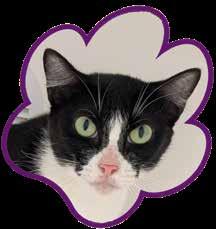
Salmon
THIS PETITE 7-YEAROLD TUXEDO CAT is as striking as she is spirited. Salmon came to us as a lost cat, so her past is a mystery—but her spicy personality is crystal clear. She’s independent and selective, but patience (and treats!) go a long way. With time and love, Salmon has the potential to become a loyal companion for someone who appreciates a cat with character.

TitusA LOVING AND PLAYFUL PUP. Titus is a social boy—he’s never met someone he didn’t like! Titus’ former owner describes him as a great dog who loves to play, has a big smile and a heart of gold. He was well trained and got along with kids and dogs in his previous home. Due to financial reasons, his owner could no longer take care of him. If you are looking for a great companion, Titus is the one for you!

SWEET, SILLY, AND READY TO LOVE. With expressive eyes and an irresistible name, Noodle is a 2-year-old, 56-pound pup who’s winning hearts left and right. This lovable guy recently enjoyed a park adventure with a volunteer and proved himself to be the perfect companion. He walked beautifully on leash, rode calmly in the car, and thoroughly enjoyed a burger and pup cup along the way. Noodle is the kind of dog who’s always up for a stroll, a snack, and a snuggle. Friendly, well-mannered, and a gentle charm that makes everyone who meets him smile. If you’re looking for a loyal buddy to explore life with, Noodle might just be the one.

Wednesday
A SENIOR KITTY WITH PLENTY OF LOVE TO GIVE—as long as you’re patient enough to earn it. Wednesday is all about love bites, licks, and rubbing her scent all over you—just to make sure everyone knows you are hers. She is looking for a patient and loving home where she can keep growing into the affectionate kitty she was meant to be. If you give her a little time to adjust, she will be the sweetest companion you could ever wish for.
YOU CAN MEET EACH OF THESE FURRY FRIENDS AT WILLIAMSON COUNTY REGIONAL ANIMAL SHELTER, OPEN DAILY FROM NOON-6PM AT 1855 SE INNER LOOP IN GEORGETOWN.






















WHAT MAKES TEXAS
“TEXAS”?

Addressing Towns with Unusual Names
by Linda A. Thornton

Giggles, sincere interest, busybody curiosity—just some of the reactions a unique group of Texas townspeople experience every time they are asked where they live.
This unofficial club never seems to tire of explaining the unusual, unique, and downright bizarre origins of their town’s names, ranging from humorous incidents to prominent residents to historical events. With true Texas pride, they will politely correct your pronunciation, assist you with spelling, and proudly affix their return address label to an envelope.
Here are some of those strange-to-us, lovable-to-others places to live. Locations are included if you decide to see them for yourself:
BUDA
Pronounced “Byoo-duh,” this city in Hays County is part of the Austin-Round Rock-San Marcos metropolitan area and is one of Austin’s fastest growing suburbs. After the Texas Mexico War, many widows were left behind. It is believed that Buda is a mispronunciation of the word “viuda,” the Spanish word for widows. Little did two widows—who worked as cooks at the Carrington Hotel in the 1880s—realize they would be honored as the town’s namesakes.

CUT AND SHOOT
Located in Montgomery County, this town of just over 1,000 residents sits 40 miles north of Houston. Its name dates back to a heated disagreement among churchgoers about steeple design, preacher choice, and land ownership. As tempers rose, a young boy suddenly shouted, “I’m going to cut around the corner and shoot through the bushes in a minute!” His outburst startled the group, and the words became immortalized as the town’s new name.
DIME BOX
This unincorporated community in Lee County once used a large wooden box for mail. Locals would leave a dime in the bottom to pay the mail carrier. When the original name, Brown’s Mill, caused confusion with Brownsville, the U.S. Postal Service requested a change. It made perfect “cents” to honor the dime box.
FROGNOT
Located about 20 miles east of McKinney, this community was plagued with frogs every time it rained. As the story goes, boys would catch the frogs and bring them to school to scare girls. After weeks of shrieking and chaos, the exasperated schoolmaster announced that frogs were no longer allowed at school. Frogs were not permitted, he declared—leading to the name Frognot.

DING DONG
This tiny community of fewer than 50 residents lies along the Lampasas River in the Killeen-Temple metropolitan area. In the 1930s, two relatives with the last name Bell ran a country store here. Their store sign, featuring two bells and the words “Ding Dong,” had a certain ring to it—and the name stuck.
HAPPY


Known as “The Town Without a Frown,” this cheerful little spot in the Texas Panhandle might owe its name to its residents—or to Happy Draw, a stream named by cowboys in the 19th century. After long, dusty rides, they were understandably happy to find water.
IRAAN
This small town with a population of a little over 1,000 is located in Pecos County. In the early 1900s, Ira and Ann Yates built a ranch upon which the town was built. Combining their first names seemed a fitting tribute to the ranchers.
NACOGDOCHES
This historic East Texas town is the county seat of Nacogdoches County and is known as the “Oldest Town in
BUG TUSSLE
The unincorporated community in southeastern Fannin County can thank an 1890s ice cream social gone awry for its name. When a swarm of bugs crashed their party, the churchgoers bravely fought off the invasion and the name was changed to commemorate the battle.
WHAT MAKES TEXAS "TEXAS"?
Texas.” It played a significant role during the Texas Revolution and was once a hub for trade. The Battle of Nacogdoches marked a key moment in the Fredonian Rebellion, when Texans attempted to secede from Mexico and establish the nearby Republic of Fredonia.
NAMELESS
Straddling the border of Travis and Williamson counties, this town is part of the Austin-Round Rock metropolitan area. Legend has it that when residents applied for a post office, every name they suggested had already been taken. Frustrated, they sent a note saying, “Let the post office be nameless and be damned!” The postmaster followed their instructions.
TARZAN
This community in Martin County might have ended up with a very different name if not for Tant and Viola Lindsay, who moved there in 1926. The couple opened a general store and hoped to establish a post office. Viola and Tant, a fan of Edgar Rice Burroughs’ Tarzan novels, had submitted several possible names, but all were rejected as duplicate town names. On a whim, Viola suggested adding “Tarzan” to the list. To their surprise, it was approved—and the name stuck.
UNCERTAIN
Located in Harrison County, this tiny town got its name by accident. When the township application was filled out, the name hadn’t yet been decided, so “Uncertain” was written in the blank. And just like that, the name became official.


EDUCATION FUNDING The Rest of the Story II
By Colonel Terry M. Wilson, US Army (Retired) Representative for TX House District 20
Last month, I gave a broad overview of the successes of the 89th Legislature and promised that I would come back with more details on each major area. As students and teachers return to the classroom this month, they do so after the most significant investment in public education since major cuts were made in 2011. Those cuts placed school districts in a tough financial position, one that legislators promised to rectify in the 89th session. In June, the 89th Texas Legislature wrapped up its regular session, closing out months of hardfought deliberations and negotiations, and delivered a historic win for public education in Texas, especially for our teachers, with House Bill 2 (HB2).

HISTORIC INVESTMENT

House Bill 2 puts $8.5 billion new dollars into public education, raising the state’s annual average investment to $17,000 per student. By delivering nearly double the increase that failed to pass two years ago, HB 2 sets a record for the largest new dedication of funds into public education in Texas history.
Of that $8.5 billion, $4.2 billion has been set aside to fix issues with the teacher pay scale. While Texas has one of the best pay rates for new teachers, up until now, that pay scale has stayed relatively flat over their career. As a result, Texas schools would often lose teachers and non-administrative staff, like food-service workers and custodial staff, with 3 or more years of experience to other states or private schools who offered a competitive pay increase over time.
RETENTION AND INCENTIVES

The fix for these pay-scale issues came in three parts.
First, there will be an across-the-board pay increase for every eligible teacher to maintain a strong baseline of educators. Teachers become eligible after three years of experience, and that increase more than doubles
once they complete five years of teaching experience.
Second, HB 2 provides targeted pay raises to support retention of teachers in at-risk rural and urban areas so our schools remain competitive. Combining these first two levels, a teacher in a rural school with five or more years of experience could see an increase of up to $8,000 in annual income.
Third, HB 2 expands the performance-based Teacher Incentive Allotment so more teachers who meet the performance goals will receive the pay increases they have earned and raises the ceiling for those incentives so top-performing teachers are more substantively rewarded. The legislature also took the extra step to make sure Texas covers the increases in their pension contributions the raises would otherwise require.
To make sure our teachers have every possible tool to achieve their performance-based incentives, HB2 also provides $187 million for teacher preparation and certification programs. These funds are provided directly to districts to make sure the pipeline of certified, qualified teachers continues to grow in every corner of Texas.
HB 2 invests in “grow your own” teacher programs to help communities
TEXAS SIT-REP
recruit and prepare local talent, pays student teachers for in-classroom training, and waives certification exam fees for bilingual and special education teachers—two areas in which demand continues to outpace supply.
The bill also introduces a $3,000 mentorship stipend for experienced teachers who agree to guide new educators through their first year in the classroom, fostering both support and retention from day one.
FOUNDATIONS FOR YOUNG LEARNERS

HB 2 doesn’t just address staffing—it’s a comprehensive overhaul of how we support students from their earliest years through graduation. The bill fully funds fullday pre-K and provides $448 million for early learning programs, including free high-quality literacy screenings and interventions to ensure children are reading at grade level by the end of third grade. It also creates new math training programs for K-3 teachers to boost student numeracy, tackling both ends of the critical early learning equation: reading and math.
SPECIAL EDUCATION REFORM

For students with special needs, HB 2 delivers a long-overdue overhaul of our special education system, devoting more than $830 million to improving access, resources, and services. For the first time, the state will also fund $1,000 reimbursements for student evaluations, removing financial barriers that too often delay diagnosis and support.
BALANCED RELIEF

Support for small and mid-sized districts is also a key part of the bill. HB 2 includes $318 million specifically to help these schools address rising operational costs and remain competitive, particularly as inflation and insurance premiums squeeze local budgets. Another $100 million is allocated to help offset regional insurance spikes that have strained district resources.

FUTURE-PROOFING AND SECURITY

Speaking of costs, HB 2 introduces a new Allotment for Basic Costs—$1.2 billion to help districts with growing expenses like utilities, Teacher Retirement System (TRS) contributions linked to teacher raises, and other operational pressures. And in a groundbreaking move, the bill ties the Basic Allotment to growth in property values, creating an automatic mechanism for future increases in school funding, so districts aren’t left waiting years for the Legislature to act.
In addition, HB 2 puts serious dollars behind school safety, with $430 million in funding to help campuses comply with new safety standards and ensure students and staff have a secure environment in which to teach and learn.
CHARTER SUPPORT

Charter schools will also benefit from $200 million for facilities funding, helping to close longstanding infrastructure gaps so that more operational dollars can be directed to students and classrooms rather than buildings and leases.
The bill also rewards innovation and time-on-task.
Schools participating in the Additional Days School Year program will see a 50 percent funding increase, encouraging extended instruction where it’s most needed to close achievement gaps and improve outcomes.
LIFE AFTER GRADUATION

And as our students prepare for life beyond graduation, HB 2 strengthens Career and Technical Education (CTE) pathways by investing $153 million to expand access to programs that prepare students for high-wage jobs and dual-credit opportunities. This investment is particularly impactful in rural areas, where access to such programs has often been limited. You will hear more about CTE and dual credit in future articles on what the 89th Texas Legislature did for higher education.
House Bill 2 is more than just a funding bill—it’s a transformational investment in Texas public education. It addresses compensation, recruitment, curriculum, special education, school safety, early learning, and workforce readiness. By raising the state’s per-student investment to $17,000, providing record-setting funding increases, and delivering targeted solutions to long-standing problems, HB 2 marks a turning point in how Texas supports its students and educators. Texas is growing—fast—and with that growth comes the responsibility to ensure our education system keeps pace. House Bill 2 is our commitment as a state to meet that challenge head-on with bold investments and forward-looking reforms that will benefit generations of Texas students to come.


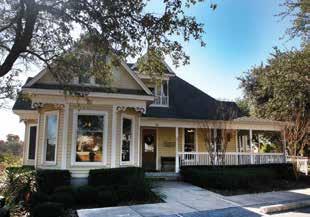

Barkin' Springs
Austin’s Coolest Dog Hangout
by Ann Marie Kennon
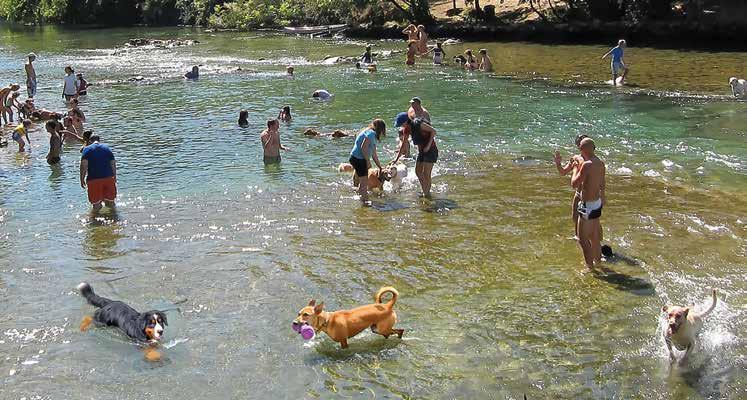
When the Texas sun starts roasting the sidewalks and the forecast reads more like a dare than a prediction, there’s only one thing to do: grab your dog, pack a towel, and head south to one of the area's most beloved, unofficial dog pools — Barkin' Springs.
Yes, Barkin’ Springs is dog-friendly and makes our curated list of the best dog-friendly places in Austin. Located just downstream from the popular Barton Springs Pool, Barkin’ Springs offers a free, natural swimming area where dogs and their humans can cool off together. This spot is a local favorite, especially during the hot Texas summers, attracting a lively crowd of college students, families, and plenty of pups. The water here stays at a refreshing 68 degrees, making it the ultimate escape from the heat.
The Scene
If you’ve never been, picture this: crystal-clear creek water flowing over smooth limestone ledges, shaded by towering pecan trees and framed by the greenbelt’s lush banks. You’ll hear the echo of excited barks before you even catch a glimpse of the water. As you make your way down the trail, the scene opens up to dozens of dogs darting in and out of the water, chasing tennis balls and making new best friends. Humans lounge on the rocky banks, some perched on towels, others half-submerged to keep cool, all sporting that easygoing Austin spirit.

Unlike its neighbor, Barton Springs Pool—which is human-only and requires an entry fee—Barkin’ Springs is free and open to all. The shared spring-fed water makes it a canine and human haven during the Dog Days of August.
Bring Your Sense of Humor (and a Towel)
Visiting Barkin’ Springs is not for the faint of heart or the clean freak. Expect to get splashed (possibly multiple times), lose track of your towel under a new dog friend, and witness spontaneous games of chase that may involve your water bottle. But that’s the fun—it’s unstructured, unscripted, and full of happy surprises.
Most dogs here are off-leash, though technically, dogs must be kept on a leash even in the water, according to city regulations. If your pup is shy or still working on social skills, stick close and watch for overenthusiastic greeters. Otherwise, let your fur baby loose and enjoy dogs living their best lives.
Something to keep in mind: Barkin’ Springs is popular with all ages and lifestyles and can get a bit raucous, especially on weekends. Many visitors enjoy adult beverages and bring portable speakers, creating a party-like atmosphere that may not be what families are looking for on a quiet afternoon. If your idea of a perfect day includes a nap under a tree, you may prefer an earlier morning visit or a weekday trip when things are calmer.
KNOW BEFORE YOU GO!
There are no lifeguards in this area of the Springs so be mindful of currents and slippery conditions. As well, before heading out, check for any city advisories about water conditions. During certain times of year, bacteria levels and algae blooms have been detected in Barton Creek and can be toxic and very harmful to dogs. Signs are usually posted on-site, but you can scan the code to check Austin city parks or Barton Springs Conservancy updates online to keep your pup safe.
Planning Your Visit

Barkin' Springs is a 30-45-minute drive from Georgetown depending on traffic and time of day. There is no admission fee for the "free side" of the Barton Springs pool and it is open to the public 24/7 regardless of residency.
Parking can be tricky, especially on weekends. There is a paid parking lot nearby at Zilker Park, and the walk to Barkin’ Springs takes you along a path just outside the Barton Springs fence. The terrain is a mix of grass, concrete, and rocks that can get slippery when wet so caution is warranted.
Bring all the food and beverages you wish, plus plenty of drinking water for yourself and your dog, along with a towel (or two), dog toys, and clean-up bags. The rocky shoreline means you’ll want something soft to sit on if you plan to stay a while.


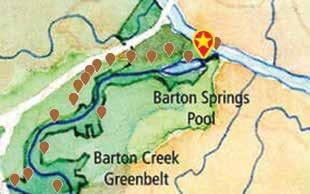
by Ann Marie Kennon
Same Calories, Less Adventure
Dogs are still living their ancestral life—no boutique fitness apps, no $8 protein shakes, no self-consciousness about what their “summer body” looks like. Just vibes, naps, and suspicious holes in the backyard.
Meanwhile, we humans have gotten so good at survival (hello, grocery delivery and central air) that we had to invent entire industries to trick ourselves into moving again. A hundred years ago, arms day was just... Monday, because survival was the workout—grind the wheat into flour, churn the butter, run from bears, and beat the dust out of the rug and quilts until our deltoids were sculpted like Terry Crews' pecs.
Sometime in the 20th century, we evolved and specialized to the point that we have something that would make our ancestors want to punch us in the throat: leisure time And yet, here we are—sitting pretty in front of as much as 21 square feet of 4K TV and we still dare to sigh, "There’s nothing on," as we scroll past 150,000-plus hours of shows and content no one asked for. And that's just from the big four: Netflix, Hulu, Amazon, and Apple TV.
In the 1960s, a coach in New Zealand told the world to "jog" for fitness, ostensibly because we hadn't been dragging deer carcasses through the snow while avoiding scavenging wolves for several decades. Just 60 years later, here we are—decked out in special clothes, buying treadmills and stationary bikes, and paying people $29.99 a month to yell "You got this!" through tiny screens. Meanwhile, our dogs lounge on the couch, and give us that now-you’re-just-embarrassing-yourself look.
If you’re cheap like me—and wise enough to realize movement doesn’t require an expensive subscription if you’d just get up and do it—you walk the dogs because you love them and it's a duty to their physiological well-being. In my 21st-century mind, “duty” is far more persuasive than “because it’s good for you” when it comes to me racking up 10,000 steps before dinner. Besides, my fur babies are basically dragging me along like personal trainers I don’t have to tip.
Walking three dogs at once is, often, less cardio and more like trying to knit a sweater with live ferrets—a cha-

otic tangle of start-stop, start-stop, sniffs, lunges, and Gordian leash knots that definitely qualify me for a Boy Scout merit badge.
Still, I envy them because dogs haven’t changed. We have. They still believe in chasing squirrels for the thrill, rolling in the mud for the spa treatment, and shaking off pond swims with a full-body turbo spin. If only I could fling water with the same gleeful abandon without having to call a chiropractor and check my deductible. I still have a sore neck when I forget to pack my special pillow that probably cost more than my great grandmother's whole bed. Ah, survival skills!
Maybe we could learn a thing or two from our pets. Less self-punishment, more joy in movement. Less app-tracking, more stick-chasing. For canine companions, the dog days aren't about sweating it out in some fluorescent-lit spin dungeon—they’re about lying belly-up on the cool tile floor, no agenda except dinner and investigating that thing that looks like a piece of Milkbone that landed within a paw's reach under the couch.
In the end, maybe they’re onto something: life’s better when you live for the simple pleasures and move for the joy of it—not because your smartwatch said so.
Dogs still run for the sheer joy of it—no mileage trackers, no heart rate monitors, no sponsored playlists blasting motivational slogans. They move because it feels good, then flop down for a nap without an ounce of guilt. And maybe that’s why they always look so content—they aren’t burdened by screens, notifications, or the pressure to optimize every moment.
Meanwhile, we have been scrolling, comparing, and chasing digital dopamine hits until we forget what real play even feels like. Dogs don’t need an app to tell them to get outside or a wellness guru reminding them to “be present.” They just are
I’ve realized my own version of a digital detox isn’t really about turning off my phone—it’s about turning off my inner algorithm. That voice that insists I should be further along, thinner, more productive, and definitely drinking more water. I’m working on unfollowing her.


PARTING SHOT

Addison Thompson’s seventh birthday fell over the Fourth of July weekend, but with the Central Texas flooding, she and her family couldn’t celebrate the way they had hoped. “I thought she’d be upset, but she was more concerned about the families and pets being displaced,” her mom, Brittany, says.
Instead of focusing on the canceled plans, Addison asked if they could do something to help. “She’s just got a big heart for animals,” Brittany says. “She just got a puppy and knows it takes a lot to take care of them.” At first, Addison suggested a lemonade stand or bake sale, but with three kids at home, the family needed something that fit their busy schedule. That’s when Brittany, who owns a T-shirt company, had an idea: “What if we design shirts and donate the proceeds?”

Through the end of August, all profits from shirts featuring Texas designs will go to the Williamson County Animal Shelter, which has taken in animals from flooded areas like Georgetown and Lampasas. “My mom said a bunch of animals went to the shelter, and they don’t have a bunch of money,” Addison says. “So we decided to make money so they can hopefully buy food, toys, and beds.”
Check out all the Texas-themed shirts on TheBAMcollective’s store on Etsy.

Seven-Year-Old Turns Birthday Weekend into Mission to Help Animals
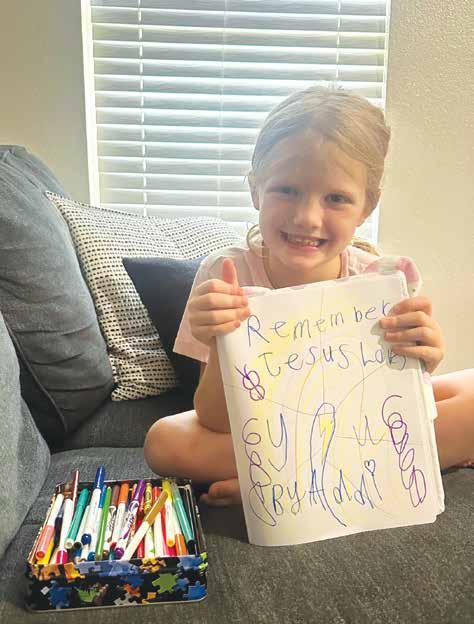
by Charlotte Kovalchuk • photos courtesy Brittany Thompson
Enjoy reading the Georgetown View every month?
Enjoy reading the Georgetown View every month?
Our great advertisers make that possible! Because of their support we are able to bring you wonderful stories that engage the mind, embrace the heart, and inspire readers to action.
Our great advertisers make that possible! Because of their support we are able to bring you wonderful stories that engage the mind, embrace the heart, and inspire readers to action.
We encourage you to show your appreciation and support these great local businesses as often as possible.
We encourage you to show your appreciation and support these great local businesses as often as possible.
Aqu Tots Swim School
Austin Orthopedic Institute - Dr. Brent Robin
Austin Window Fashions
Blinded by the Light
Cen Tex Towing
Cockrum Homes
Countryside Pet Resort
Doleva Elite Tree
DTC Air Conditioning & Heating
Family Emergency Room of Georgetown
Gene’s Auto Repair & Service Center
Georgetown Chamber of Commerce
Georgetown ISD
Georgetown Palace Theater
Grand Endeavor Homes
Hall’s Roofing & Sheel Metal, Inc.
Innerspace Cavern
Jarrell ISD
Keller Landscape
Keller Williams Lone Star Realty
Kids’ Zone
Laneways Enterprises
Mill Direct Carpet & Flooring
Moore Liberty Buildings
Mutz and Kutz
Next Gen Academy

Precision Tune Auto Care
Prime Wellness & Longevity
Relentless Rides
San Gabriel Oral & Maxillofacial
Surgery Associates, P.A.
Sky & Co. Jewelry
St. John’s Methodist Church
Sun City Community Association
Texas RV Service & Repair
The Wesleyan
Wild Birds Unlimited

